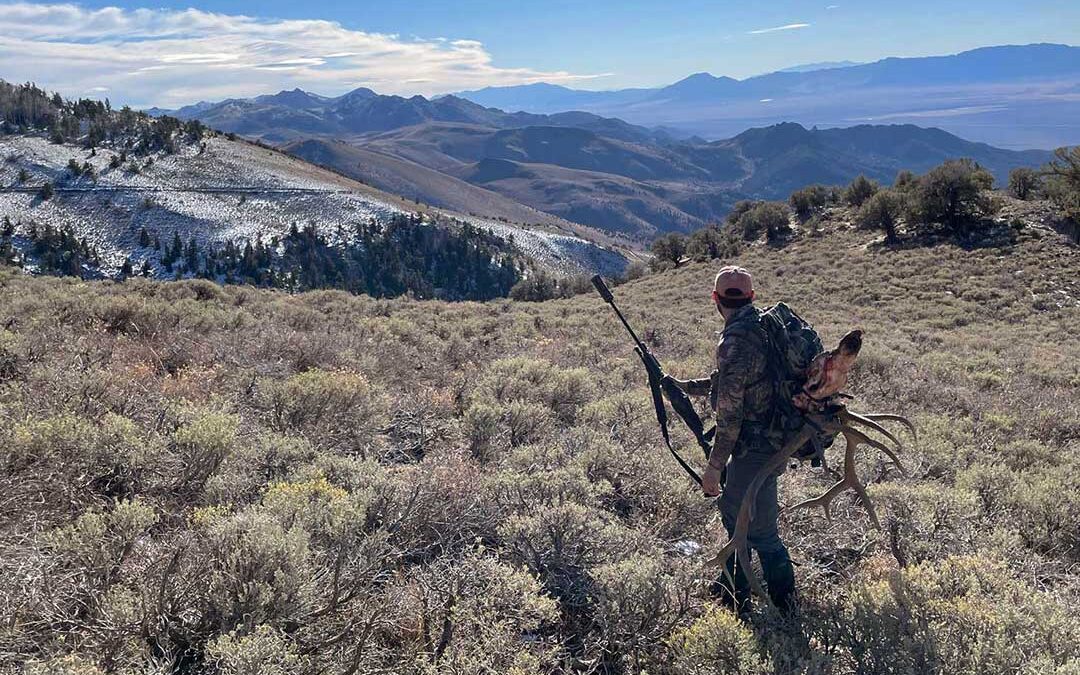Peering through my scope into a magnified world filled with elk, it almost felt like a dream. The herd was probably 60 strong, and a third of them were bulls. The larger ones, the six-points, of which there were several, seemed agitated and darted here and there, sounding off with bugles as steam shot out of their mouths and nostrils.
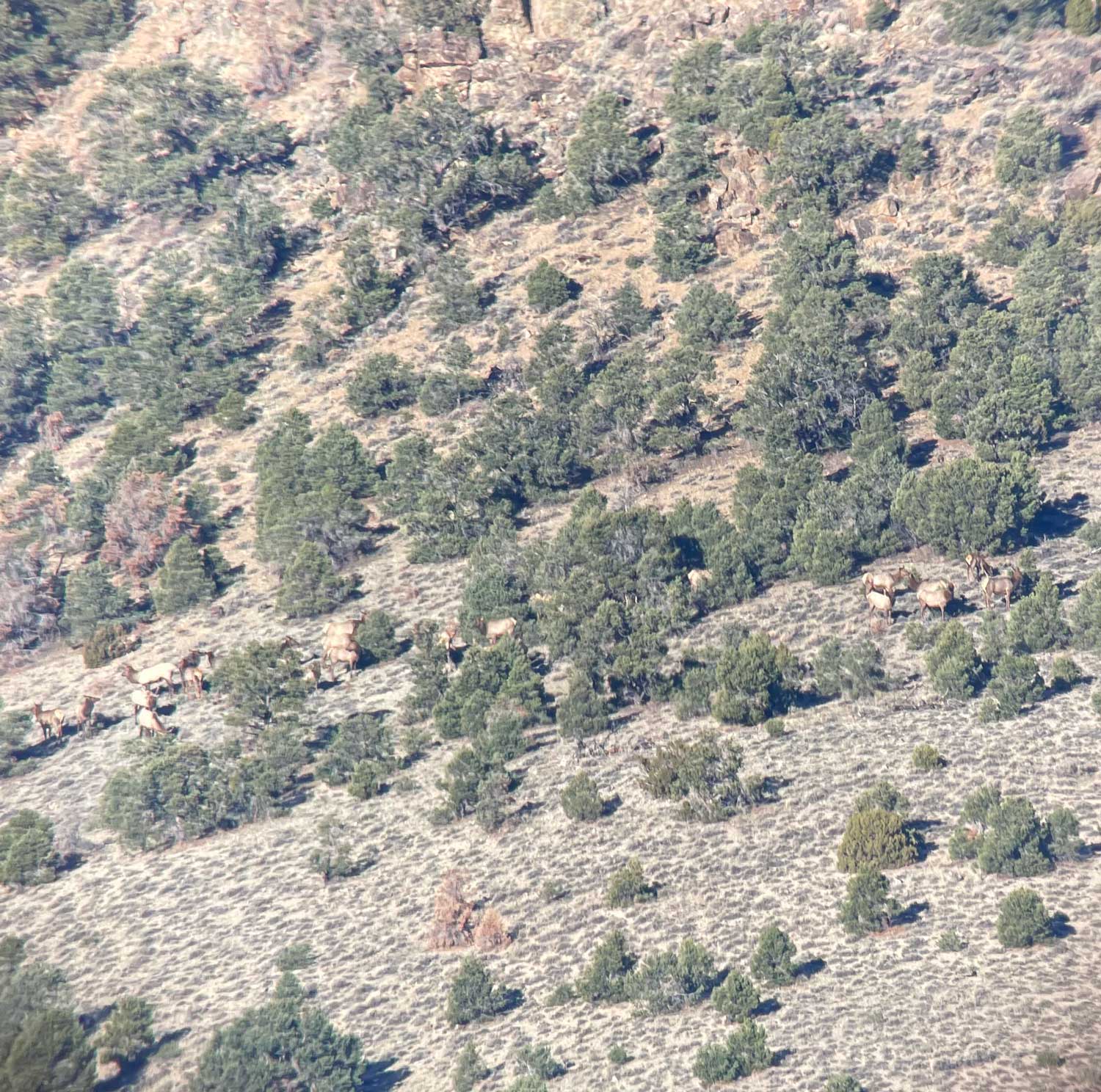
In a lifetime of elk hunting, I had never experienced anything like it. There were multiple 6×6 bull elk in my scope, but the safety of my rifle never came off. On any other elk hunt I had ever been on, any one of those bulls would have been deader than Thanksgiving turkey, but with a late season Nevada bull elk tag in my pocket, the occasion called for restraint. Since waking in our tent at the base of the mountain earlier that morning, my hunting partner, Chess Carbol, and I had ridden for 45 minutes to the wilderness boundary on my ATV and then hiked straight up the mountain on a finger ridge into the wilderness area. It had taken 10 minutes less than our estimated three hours to reach the top of the mountain, which was good, because as soon as the faintest amount of light appeared from the east, a bull elk sounded off, his bugle cutting through the crisp air, chilling and raw. It was followed by another bugle, then another, and they were all close.
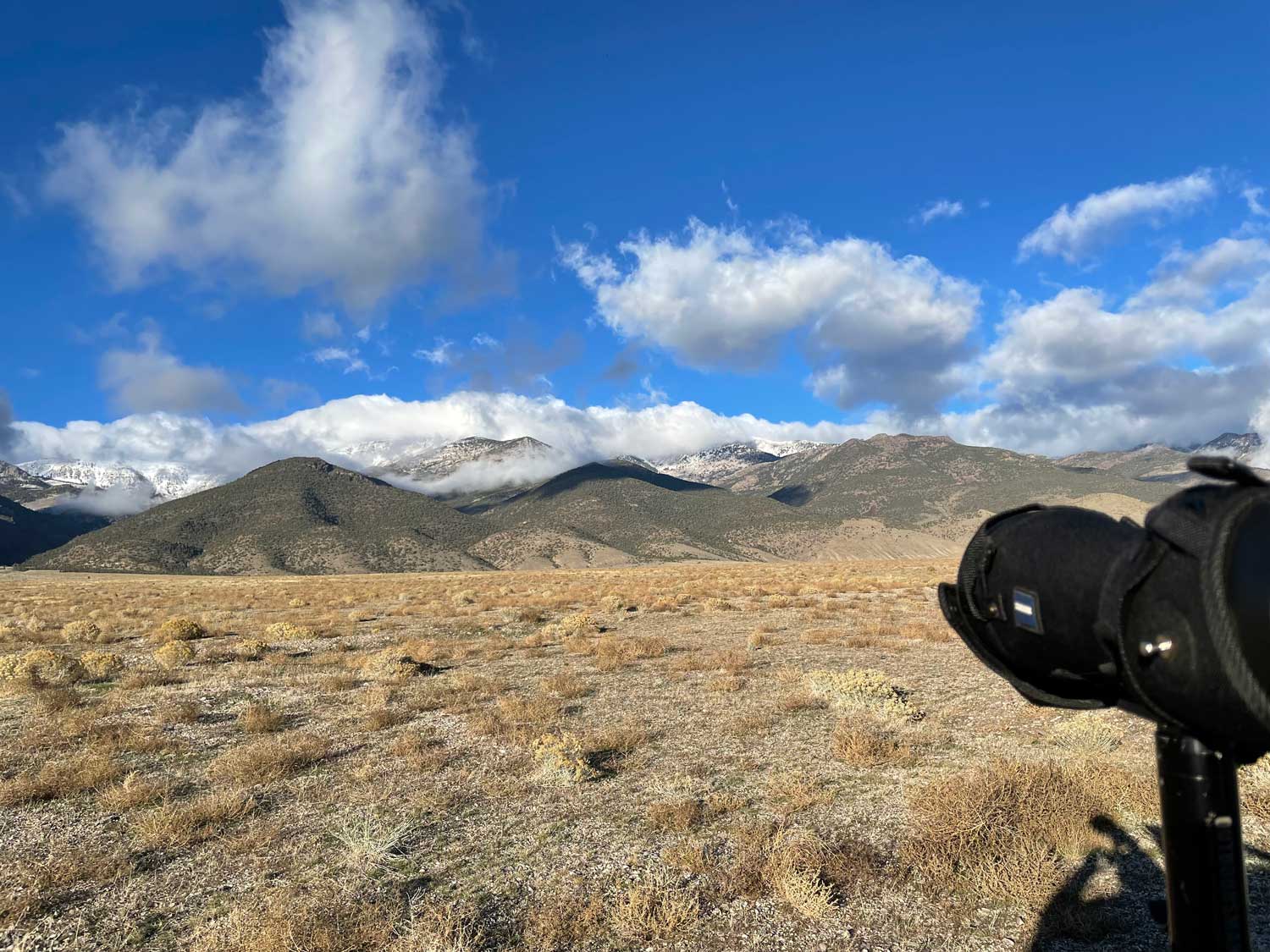
I didn’t know why so many bulls were bugling in late November, but I wasn’t about to complain.
It was too early to shoot, but when I raised my binocular toward the action, the optics lit up the darkness and I saw that the adjacent hillside was covered with yellow bodies.
Chess and I kept tabs on them in the faint light, but when the time for legal light had come and gone, I hadn’t fired a shot.
“I’ve got nothing,” I told Chess, laying prone behind my rifle. He agreed. We watched the herd crest the ridge and head into the next canyon. All in all, we figured being in rifle range of 60 elk, 18 of which were bulls in the first 10 minutes of light a pretty good way to start any elk hunt.
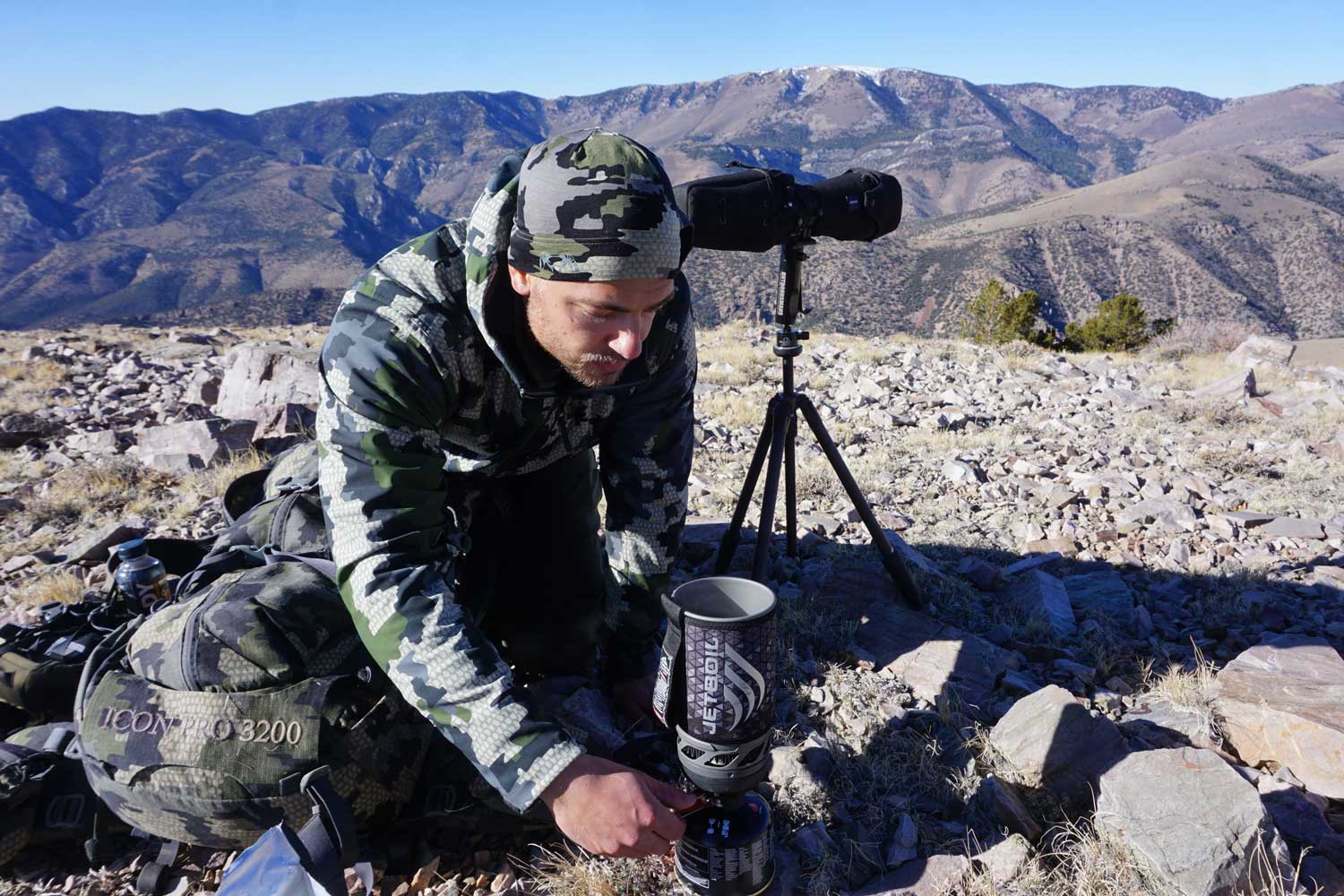
The author’s hunting partner, Chess Carbol, prepares a dehydrated meal from their glassing location on opening morning.
A Nevada bull elk tag is a special thing, especially for a nonresident. Nearly 4,000 hunters put in for less than 10 nonresident tags in the area I drew. I had hunted Nevada twice before and killed a pronghorn and a mule deer. On those hunts, I fell in love with the state. Nevada possesses everything from towering snow-capped peaks to scorching deserts and is characterized by the ruggedness the American West is famous for. The desolate vastness makes a hunter feel as if he may as well be hunting on the moon, and the state is addictive for those who seek to isolate themselves in the wildest of wild places.
The remote, unpaved roads are terrible and seem to put a year’s worth of wear on a truck in just a few miles. Gas stations can often be hours away, which means most hunts require more preparedness than other domestic hunting grounds, but the big game hunting is some of the best in the United States. Nevada’s game management strategy for elk is catered to quality and not high opportunity.
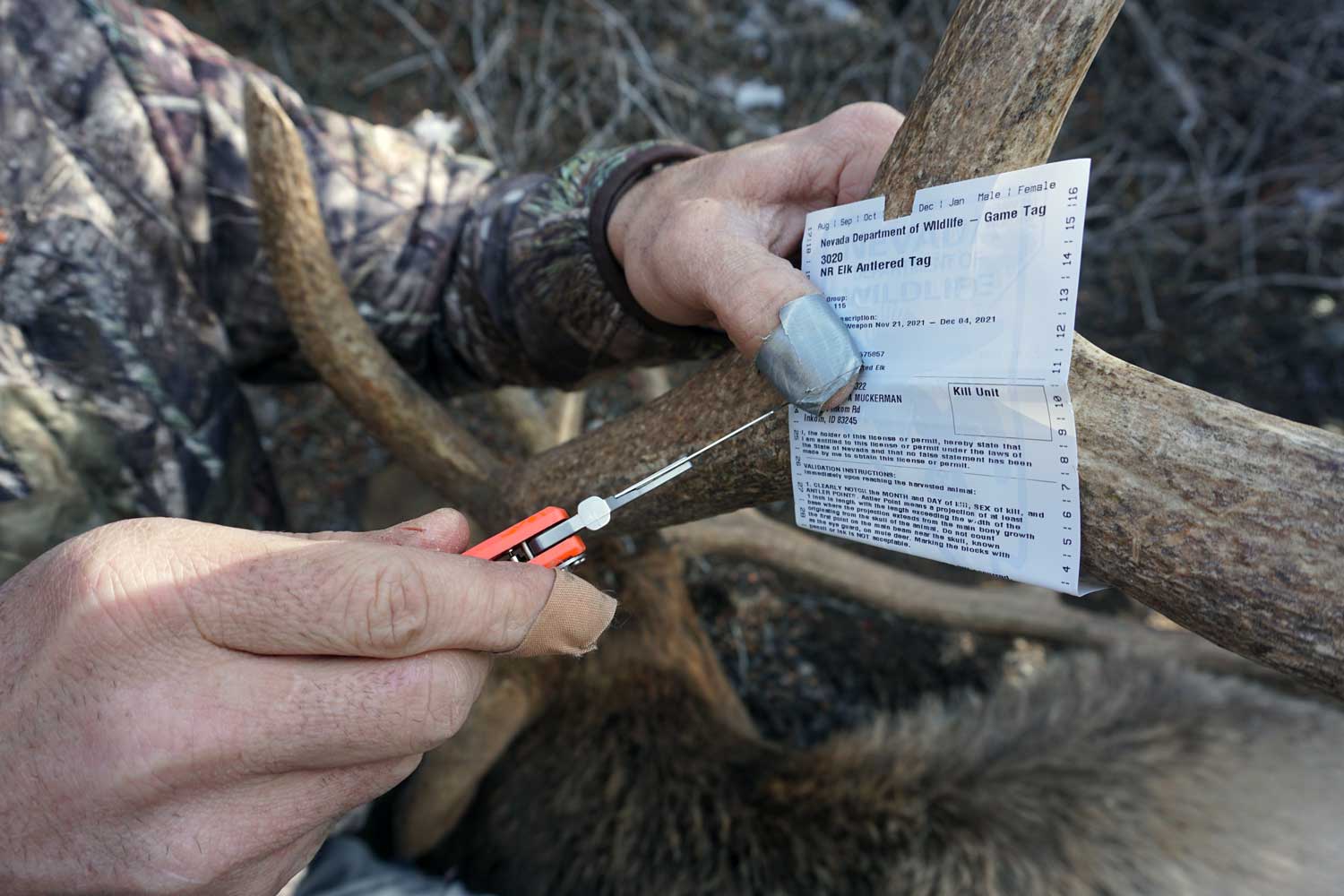
I have played the western draw tag game for a long time, and some years I have done better than others, but 2021 was something special. For Chess and me, it was the type of year that hunters openly fear, ostensibly, but deep in the recesses of their mind, they wonder “what if,” and usually with a mischievous grin.
We drew too many great tags.
In addition to my elk tag, my 10-year-old daughter had drawn a bull moose tag and Chess had pulled a mountain goat tag, both in our home state of Idaho. Each of the three hunts needed a season’s worth of work to do them justice, so we buckled down and started early. The idea of turning back a great tag to hunt another great tag never entered our minds. We’d just team up and hunt them all.
When the snow began receding in Idaho’s high country in early summer, we started scouting for mountain goats, hiking for miles into the wilderness glassing for goats and living off water from high alpine lakes and brook trout cooked in tin foil. During mid-summer, we took a trip south and hunted javelinas and then journeyed to Hawaii to hunt draw tags for axis deer and sheep.
When goat and moose season began on August 30 in Idaho, we made every trip count. Once we had a goat and a moose on the ground, we hunted some over-the-counter tags when time permitted. By the time mid-November rolled around, the last hunt loomed large. The hunt would be in “Big Country” at a time when weather can be a serious factor. I questioned my sanity for going unguided more than once.
After the large elk herd had filed over the mountain into the next drainage, we set up our tripods and spotting scopes and continued searching for a good bull. We found elk periodically throughout the day, but it wasn’t until an hour before dark when things got really interesting.
“I’ve got a good one,” Chess said, his eye glued to his spotting scope that was angled below us.
I spun my spotter and he talked me into where the bull was by using terrain features. Once I found the elk, I knew he was what we were after.
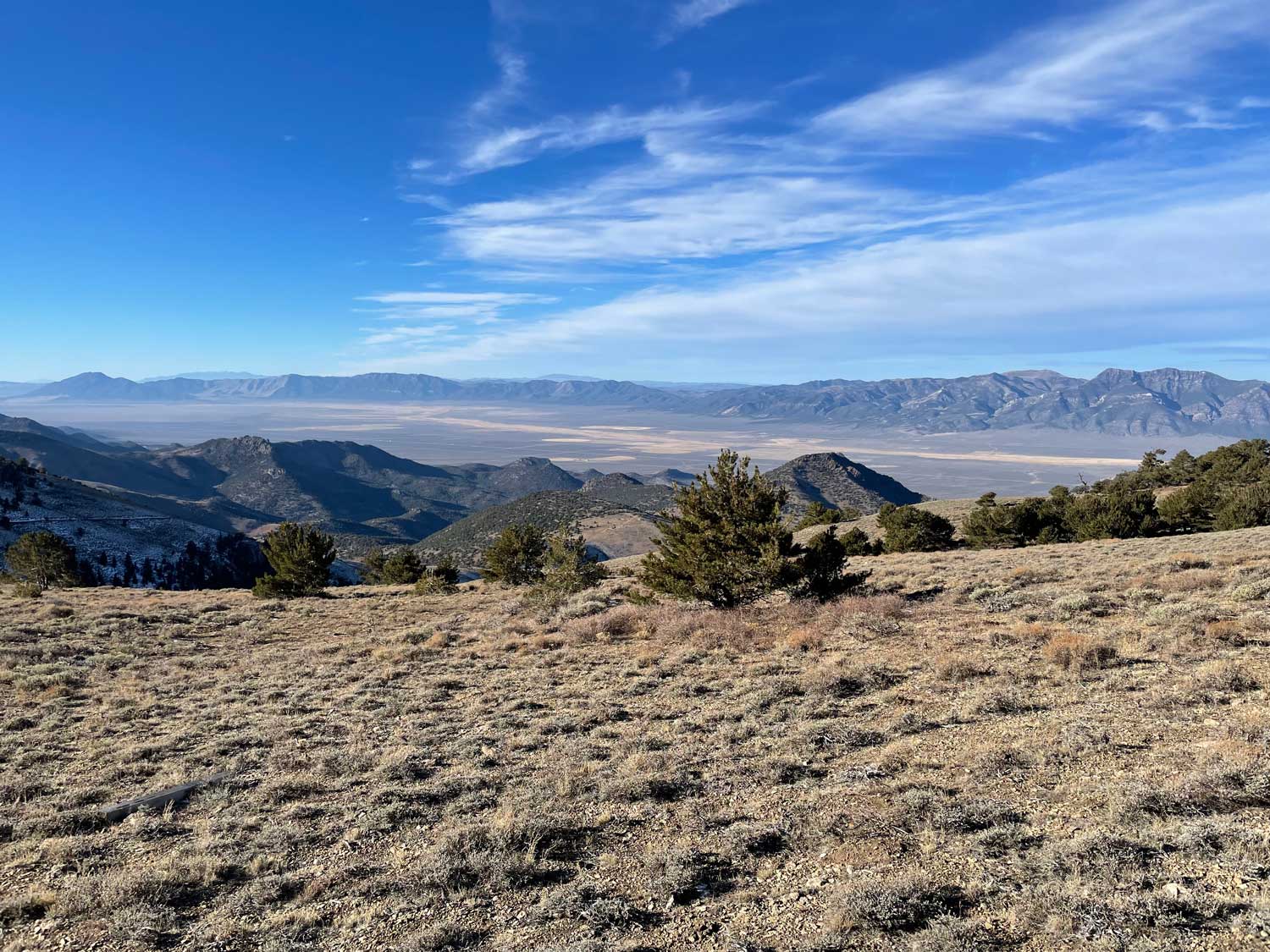
Hunting Nevada means hunting big, desolate country.
I looked closely at the bull and saw his rack extended impossibly far back and all of his tines were long with gnarly curves—a true Nevada giant. He was also below us, which would aid in getting to him quickly before dark. We figured he was about a mile away and we could get about halfway there, or a bit more, according to the scale on our maps. He was right at the fringe of my effective range if we dropped down the mountain, crested over a rise and shot straight across the canyon. There was, however, a problem.
The elk was on a face that was nearly vertical. He was surrounded on all sides by rock cliffs that were hardly steeper than the slope he was on. Getting down to him and getting a shot was possible, but the more we looked at the face he was on, we realized that if I shot him and he dropped where he was, we would possibly not be able to physically get to him.
He hadn’t gotten so big being stupid and parading around in the low rolling sage hills for all to see. He was on an impossible mountain face in an area that could only be glassed after a three-hour hike into the wilderness area, as we had done.
In preparation for this hunt, I’d spoken to multiple previous tag holders, and I’d heard from several that some of the big bulls will go to “mountain goat country” after they get pressured. Chess and I had spent June through September in Idaho’s mountain goat country scouting and hunting his goat tag. I figured we would be fine and the other hunters just weren’t used to the steep stuff.
They had been right; I had been wrong.
After going back and forth with Chess, we faced the reality that I could probably kill the elk, but may not be able to recover him. At dark, we began the three-hour journey back to our tent without having made a play on the big bull.
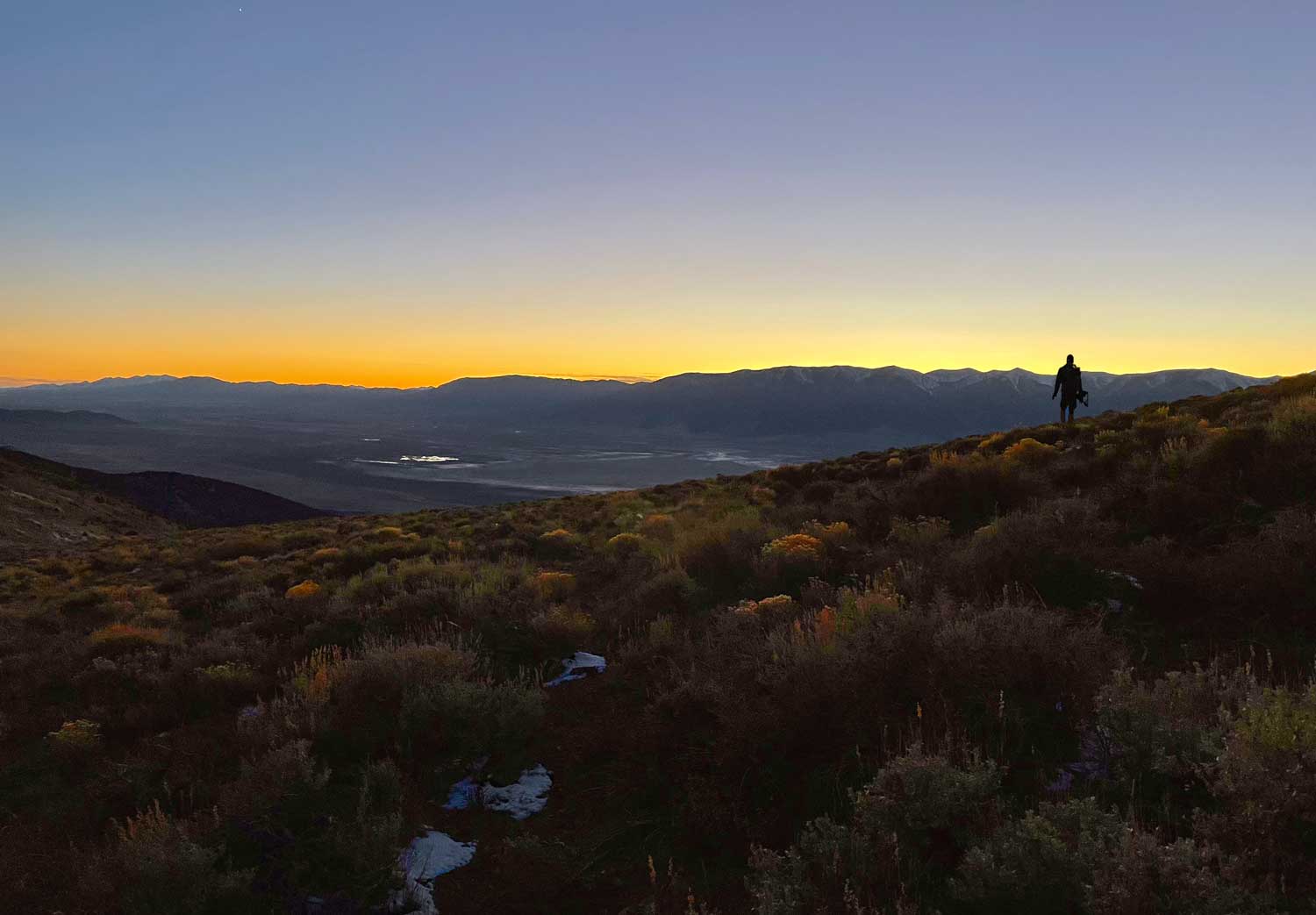
The next morning, we decided to glass from the bottom of the range and cover as much territory as possible, hoping to turn up a good bull we could climb to and pursue. We found elk throughout the day, and spotted several marginal bulls, one of which Chess had to drag me away from against my will, knowing my trigger finger was doing the thinking, and not my brain. We had, after all, joked before the trip that his job was to hold my ammunition for me so that I didn’t fire them at something the tag wasn’t worthy of.
By the prime time of the evening, we were on the other side of the range from where we’d begun at camp, deep in the mountains in a spot that looked promising.
We’d taken the ATV as far as we could, then began glassing. As soon as my binocular hit my eyes, I saw two elk that looked promising in the distance. They were standing in nasty terrain, one hoof-slip away from a 400-foot vertical fall.
“Just above those white cliffs,” I told Chess.
Chess adjusted and dialed the focus knob on his spotting scope.
“Both are good bulls,” he said.
I took a peek through his spotter. A two-second glance was all I needed. We dropped out of sight and started making our way as quickly as we could to the next ridge that we hoped was close enough to shoot from.
We made it to a shooting position with 25 minutes of light left. When we crested, we spotted one of the bulls and figured the other was behind some brush in a small patch of piñons and junipers.
I ranged the bull and found he was just 15 yards short of my predetermined shooting distance limit, and we couldn’t get any closer. The wind was almost nothing, a slight tailwind, barely perceptible. I checked my range card, dialed my turret and settled behind the rifle prone. I thought of the practice I’d done throughout the year, and the holes I’d punched in paper at the same distance. Shooting paper is different than shooting fur, but knew I could make the shot.
Chess stood behind me looking through his spotter, hoping to see exactly where the bullet would hit. I checked the level and made sure the bubble was in the middle and tried to calm my heart rate.
“You ready?” I asked Chess.
“Smoke him.”
I inched the crosshairs into the bull. He was almost broadside, but not quite. The side of his butt showed, as well as his front half, a dark mane on a light brown body, and a set of antlers that looked big, but uneven from several broken tines. He looked stately and regal yet bruised and battered.
I checked the level again in my peripheral, shifted back to my sight picture and squeezed the trigger. The suppressed 7mm barked and I lost sight of the bull from the recoil while subconsciously working the bolt.
“You dropped him!” Chess said. “I saw the vapor trail drop right into his chest.”
I peered through my scope just in time to see the other bull push out of the trees above and head toward the top of the mountain. Then I saw my bull stumble out of the juniper patch into the open, sick and showing it, but back on his feet. I found his shoulder and sent another shot across the canyon. The bull stumbled, turned around and then headed back into the trees and out of sight.
We stayed where we were, glued to our respective optics because it was too late to get to him before dark. When darkness fell, he hadn’t revealed himself again.
After getting off the mountain, I sprung for a hotel in town for the night, as our camp was an hour and a half away and I craved a shower and some rest. I got the shower, but despite spending the first several nights of the hunt in single-digit temperatures in a tent and sleeping fine, sleep escaped me in the plush bed of the hotel. I just watched the clock go through the hours until it was time to get dressed and reveal the mystery of the bull.
Using our maps, we found the best way to reach the elk. Between the truck, the ATV and hiking, it took several hours of traveling to get to the rise in the terrain that would give us a 100-yard view into the patch of trees we’d last seen him in.
I slowly crested the rise, watching my footing, trying to stay silent while peering over, hoping for the best, but prepared for the worst with a round chambered, my scope turned to the lowest power and my finger ready to hit the safety and shoot if the bull was hurt but not dead.
As soon as I gained the ridge, I saw a golden body shining in the morning sun and the main beam of his rack tipped on its side in a big arch above his body. He was 10 yards from where we’d last seen him the night before when he entered the patch of trees, and he was dead.
In an instant, a pressure inside of me that had been building and growing for months instantly melted away. I felt different, physically—an immediate shift—and I fell to my knees. It is a conundrum, the idea of doing something for enjoyment and satisfaction but to then feel relief when it is over. I didn’t need to fully understand it, but if completing a hunt that was 14 years in the making made me feel nothing, then perhaps it didn’t mean anything to me in the first place.
I felt thankful. Thankful for the animal and the opportunity, but mostly thankful for a friendship so deep that Chess would drop everything to be here, to help and be a part of the adventure. I hadn’t even had to ask him. When I had texted him a screenshot of the draw results back in May, he asked for the dates so he could get off work.
I knelt there for a while next to Chess. I didn’t say anything, because words were hard.
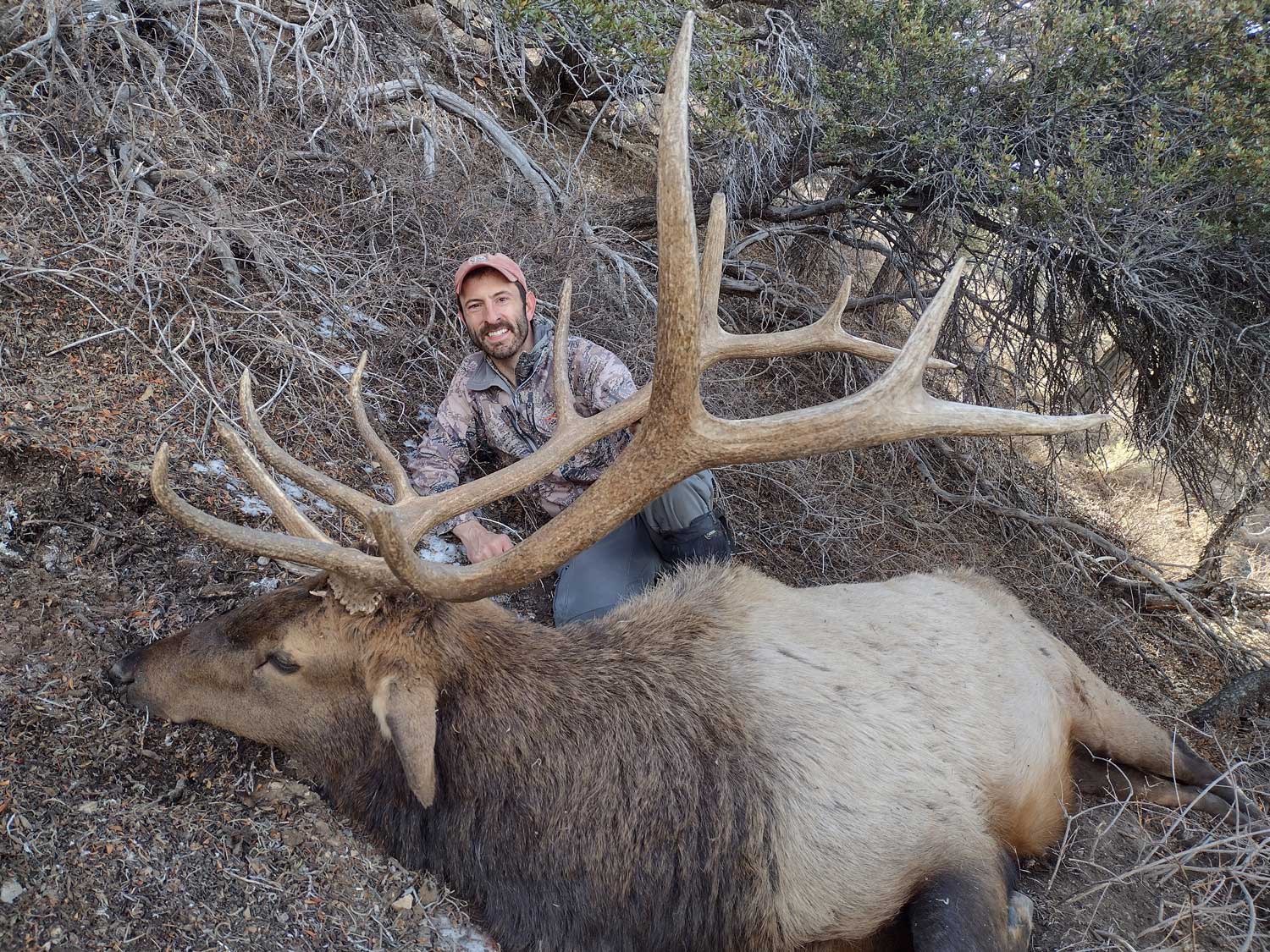
The bull was everything I hoped for in a Nevada bull. He was a busted-up, nasty old brute, and his rut had apparently been a busy one because seven of his 12 tines were broken to some extent. He was perfect.
Once words could come, we sat with the bull and recounted the hunt, and after we’d exhausted the details, adventures and misadventures that had led us to the bull, we recounted the year of hunting that we both felt could never be topped.
Having never taken the time to really add things up until then, we realized we’d been together for hunts for 10 species of big game animals in five different states in just one year of hunting.
Chess’ goat hunt, which spanned 13 days and more than 100 miles of hiking, ended with an old billy killed nine miles into the wilderness. We’d chased moose together looking for a bull for my daughter who’d gotten lucky and drawn her first year trying, and she was able to make a great shot on a bull on the fifth day. We’d melted in the Hawaiian tropical summer sun chasing axis deer and froze while sitting on countless wind-swept ridges behind our optics looking for the flick of an ear or the turning of a head from a creature hidden in the foliage. We’d heard turkeys gobble, elk bugle and the baying of our hounds as they chased cougars and bobcats. We’d added new species that we’d never hunted, like stinky javelinas and delicious axis deer, and hunted familiar ones in both old haunts and
new areas.
As we scaled the mountain one last time, we closed the final chapter of a year of epic adventures. Laden with packs heavy with meat and antlers and another lifelong memory together, the weight didn’t feel all that bad.

